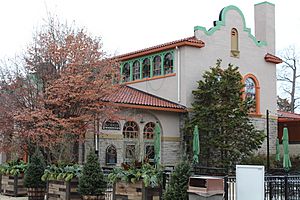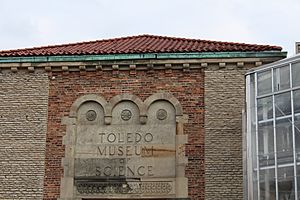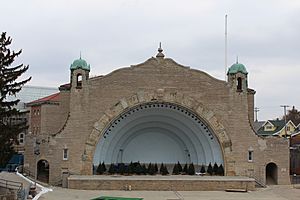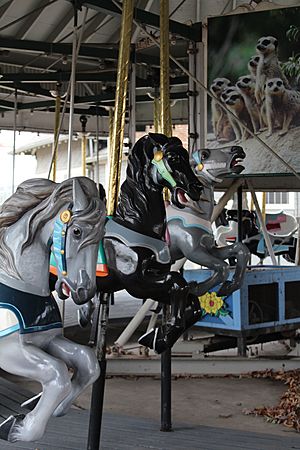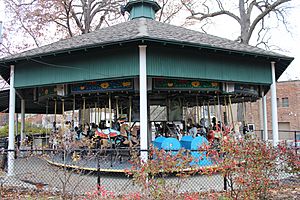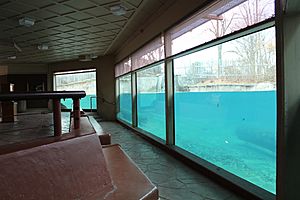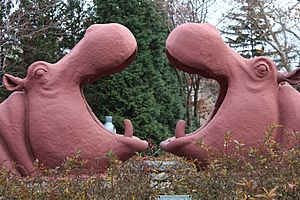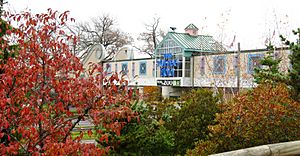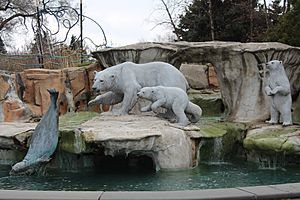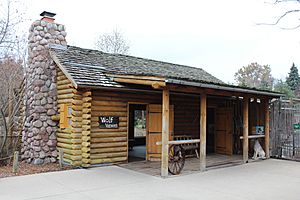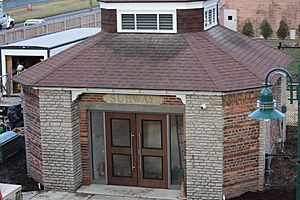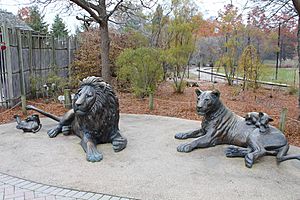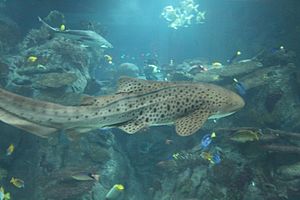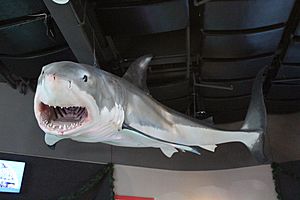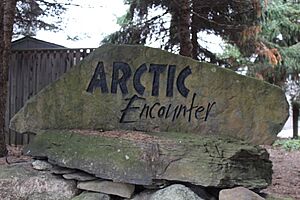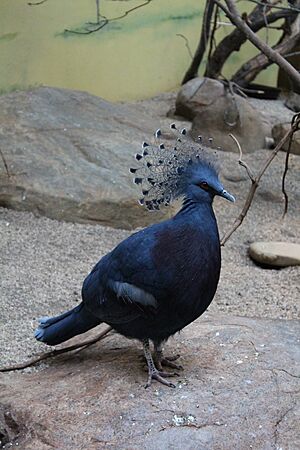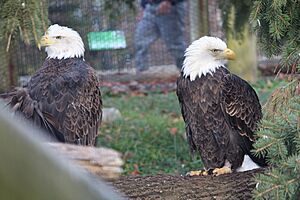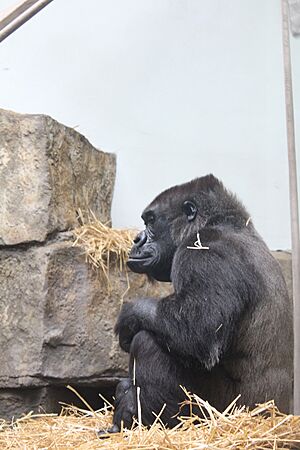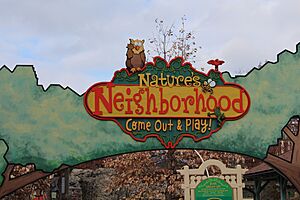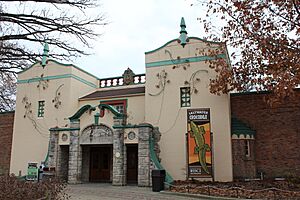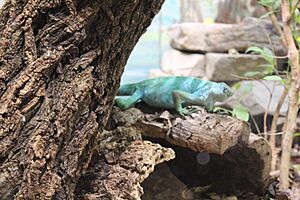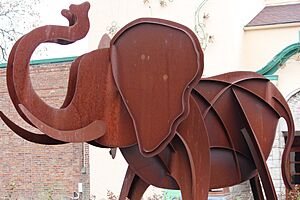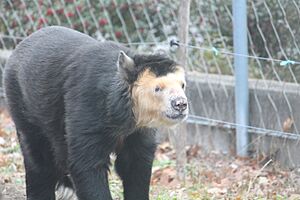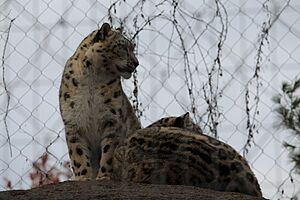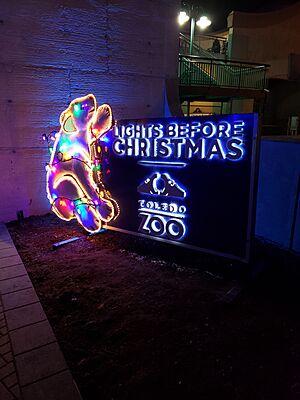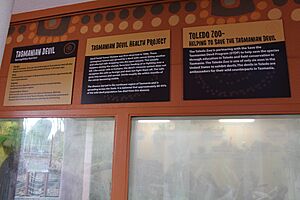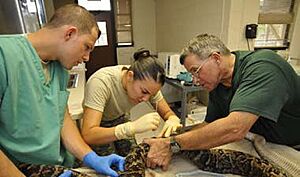- This page was last modified on 15 June 2025, at 10:58. Suggest an edit.
Toledo Zoo & Aquarium facts for kids
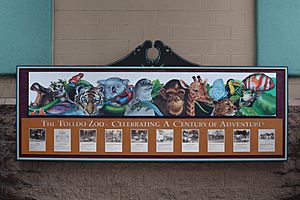 |
|
| Date opened | 1900 |
|---|---|
| Location | Toledo, Ohio, United States |
| Land area | 51 acres (21 ha) on south side |
| Coordinates | 41°37′09″N 83°34′51″W / 41.6191°N 83.5807°W |
| No. of animals | 10,000 + |
| No. of species | 720 |
| Memberships | AZA, WAZA, BFCI |
| Major exhibits | Africa!, Aquarium, Arctic Encounter, Aviary, Maned Wolf, Bald Eagles, The Valley, Nature's Neighborhood, ProMedica Museum of Natural History, Primate Forest, Reptile House, Snow Leopards, Flamingo Key, Tiger Terrace, Ziems Conservatory, Tembo Trail, Penguin Beach, Cassowary Crossing, Galapagos Gardens |
The Toledo Zoo & Aquarium is a super cool place in Toledo, Ohio. It's home to over 10,000 animals from 720 different types of species! Imagine all those amazing creatures in one spot. The zoo is part of important groups like the World Association of Zoos and Aquariums (WAZA). It also helps protect animals through more than 80 special programs. Lots of people love visiting, with over a million visitors each year.
Contents
- History of the Toledo Zoo
- Explore the Exhibits
- Africa! Exhibit
- Amazing Aquarium
- Arctic Encounter
- Wonderful Aviary
- The Rescue Roost
- Cassowary Crossing
- Ziems Conservatory
- Flamingo Key
- Kingdom of the Apes
- ProMedica Museum of Natural History
- Nature's Neighborhood
- Penguin Beach
- Pheasantry
- Primate Forest
- Reptile House
- Tembo Trail
- Tiger Terrace
- Snow Leopards
- Fun Events and Attractions
- Helping Animals: Conservation Efforts
- Awards and Recognition
History of the Toledo Zoo
How the Zoo Started: 1900-1920
The Toledo Zoo began in 1900 with a simple gift: a woodchuck! It was given to Walbridge Park. Soon, more animals were donated. By the end of its first year, the zoo had 39 animals. They even had to use temporary homes like ravines for some exhibits.
In 1901, a fire almost destroyed all the animals' winter homes. Because of this, the zoo built its first brick building in 1907. It was called the Lion House. In the early days, animals often came from donations or circuses. Sometimes, animals would even escape because their homes weren't strong enough!
In 1913, the Toledo Zoological Society (TZS) was created. This group helped the zoo grow. By 1916, the zoo had 471 animals. In 1922, Frank Skeldon became the first Zoo Director. He helped make the zoo famous across the country.
Building Big: 1920-1929
In the 1920s, the Toledo Zoo made a big plan for new buildings. They looked at the best zoos in the world for ideas. The new buildings were inspired by Spanish architecture, like the city of Toledo, Spain.
The first new building, the Elephant House, was finished in 1924. To get money, the zoo worked with the City of Toledo. In 1926, the zoo became a mix of public and private ownership. This meant the city helped with money, but the TZS ran the zoo.
The Carnivora Building opened on Christmas Day in 1927. This was followed by the Herbivora (Giraffe House) in 1928. The Primate House was completed in 1929. These buildings were very important for the zoo's growth.
The WPA Era: 1930-1940
During the Great Depression, the zoo got help from government programs. These programs, like the Works Progress Administration (WPA), created jobs. In 1934, work began on the Reptile House. The zoo even used parts from old buildings to save money!
The Reptile House opened in September 1934. It housed over 485 reptiles and amphibians. On the same day, work started on the Museum of Science and the Amphitheater. The Amphitheater was finished in 1936. The Museum of Science opened in 1938.
More WPA buildings were added. The Aviary, built in 1937, was special because it was the first building in the country to use glass blocks for walls. The Aquarium, opened in 1939, was also amazing. It was the first public aquarium in Ohio. It was also the largest freshwater aquarium in the world at the time! Many of these WPA buildings are still used at the zoo today.
After the War: 1940-1980
After World War II, the zoo added fun new things. In 1946, they got a ridable miniature railway. In 1949, they started their magazine, Safari Magazine. Philip C. Skeldon, the son of the first curator, became the new director in 1953.
Under his lead, the zoo planned new attractions. These included Wonder Valley, a petting zoo, and open-air exhibits. They also added rides like a merry-go-round and a helicopter ride. By 1953, the zoo had 3,537 animals.
In the 1960s, the zoo added educational Talking Storybook Kiosks. They also went on a safari to South America! This trip helped them bring back 75 new species. In the 1970s, the zoo started classes in animal care. They also added Cheetah Valley and Monkey Mountain.
A New Beginning: 1980-2000
In the early 1980s, the Toledo Zoo faced big money problems. Many staff members were laid off. The Museum of Science and the conservatory even closed. But people worked hard to save the zoo.
In 1981, William "Bill" Dennler became the new director. With support from many people, the zoo raised enough money to stay open. In 1982, the Toledo Zoo became a private, non-profit organization. This meant it was run and funded by the Toledo Zoological Society.
The zoo started to get better. The Greenhouse/Conservatory reopened in 1982. A children's zoo opened in 1983. In 1986, the zoo started building its African Savanna exhibit. This included the first Hippoquarium, where you could see hippos underwater!
Because of the Hippoquarium's success, the zoo got to show two giant pandas from China in 1988. This was a huge event! Over a million people visited the zoo that year. In 1997, a pedestrian bridge was built to connect the two parts of the zoo. The Arctic Encounter Exhibit opened in 2000.
Today's Zoo: 2000-Current
After celebrating its 100th birthday, the zoo opened the Africa! exhibit in 2001. A wolf exhibit followed in 2002. By 2003, the zoo's breeding programs were very successful. They had baby sloth bears, elephants, and tigers. The birth of an African elephant was very special!
In 2007, the zoo planned many improvements. These included a butterfly house and a new children's area. They also planned to update the old Aquarium building. In 2010, the zoo added a SolarWalk. This walkway has solar panels to help power the zoo.
In 2014, Penguin Beach and Flamingo Key opened. In 2015, the Aquarium project was finished. The zoo officially changed its name to the Toledo Zoo & Aquarium. The Museum of Science was also updated and reopened in 2019 as the ProMedica Museum of Natural History. In 2018, the zoo reopened its underground subway crossing.
Explore the Exhibits
Africa! Exhibit
The Africa! exhibit opened in 2004. It's a huge area, about 12 acres. The main part, the African plains, is 5 acres. Here, you can see animals like Grant's zebras, Masai giraffes, ostriches, and blue wildebeest roaming freely. There's also a special section for cheetahs.
You can watch the animals from an observation deck. The Safari Railway circles the Africa! exhibit, giving you a great view. There's also an African animal carousel for fun. In 2017, two baby Masai giraffes, Kipenzi and Binti, were born here!
Amazing Aquarium
The Toledo Zoo & Aquarium has one of the best collections of water animals in the United States. The Aquarium closed for updates in 2012 and reopened in 2015. The new Aquarium has over 3,000 water animals. It holds 178,000 gallons of water! The biggest tank alone holds 90,000 gallons.
You can even touch some animals in the new touch tanks. There are stingrays, small sharks, starfish, and hermit crabs. The outside of the old WPA building was kept during the updates. You can see all sorts of fish like zebra sharks, clownfish, electric eels, and even a giant Pacific octopus!
Arctic Encounter
The Arctic Encounter is home to animals from cold places. You can see grey wolves, gray and harbor seals, and polar bears. The exhibit has waterfalls and streams.
The seals have a big area with land and saltwater. The polar bear exhibit has lots of land and water for them to enjoy. There's even a "kids' cave" where you can pretend to be a polar bear! In 2022, two polar bear cubs were born here for the first time in many years.
Wonderful Aviary
The Aviary is filled with beautiful birds. In the first room, you'll see demoiselle cranes and rhinoceros hornbills. There's also an Australian walkthrough area. Here, you can feed budgerigars and other birds from Australia, Asia, or Africa.
You might spot Victoria crowned pigeons, Gouldian finches, and even a Raggiana bird-of-paradise. There's a special children's area too. It has emperor tamarins, lowland pacas, and Linnaeus's two-toed sloths.
The Rescue Roost
This exhibit is for bald eagles that have been rescued. They might have injuries, like a broken wing or a blind eye. It's a place where they can live safely.
Cassowary Crossing
Cassowary Crossing is where you can find the amazing southern cassowary. These large, colorful birds are known for their unique look.
Ziems Conservatory
The Ziems Conservatory is open all year. It's a great place to see and learn about different plants. It's also the winter home for the Galápagos tortoises.
Flamingo Key
Flamingo Key is an outdoor pond area. It's home to bright pink flamingos, Dalmatian pelicans, and scarlet ibises. You can also see other local and exotic waterfowl here.
Kingdom of the Apes
The Kingdom of the Apes opened in 1993. It's home to Bornean orangutans and western lowland gorillas. The gorillas have a large outdoor area called Gorilla Meadow. The orangutans have a pool and climbing structures.
The zoo used to have chimpanzees, but after they passed away, the zoo decided not to continue that exhibit.
ProMedica Museum of Natural History
This museum first opened in 1938 as the Museum of Science. It teaches you all about natural history. It closed for big updates in 2017 and reopened in 2019. Now it has a two-story tropical rainforest atrium! It's filled with trees, bushes, and orchids.
On the main floor, you can explore Ohio's past. See models of animals like wooly mammoths and saber-tooth cats that once lived here. Learn about creatures in Ohio's rivers, streams, and lakes. You can even touch lake sturgeon in a special tank.
The upper level focuses on venomous creatures. You'll find exhibits on tarantulas, black widow spiders, and many types of Venomous Snakes. There are also two enclosures for the zoo's Komodo dragons.
Nature's Neighborhood
Nature's Neighborhood is right next to the Museum of Natural History. It's a hands-on area for kids. You can meet African pygmy goats, silkie chickens, and guinea pigs. There are also honeybees and leafcutter ants.
The area has a Play Stream, a Contact Yard where you can interact with animals, and a big playground. It's designed to be safe and fun for children. It teaches kids about conservation and animal care.
Penguin Beach
Penguin Beach was built in 2014. It's home to African penguins and different kinds of ducks. This outdoor exhibit has an overhead bridge and an underwater viewing area. You can watch the penguins swim and play! Many baby penguins have been born here since it opened.
Pheasantry
The Pheasantry is near the Historic Carousel. It has an outdoor viewing area for many birds, especially gamebirds. You can see birds like the Elliot's pheasant and the Himalayan monal. It also houses the kiwi bird.
Primate Forest
The Primate Forest is in the Main Plaza. It's home to many different primates. You can see ring-tailed lemurs, black-and-white colobuses, and red pandas. There are also white-cheeked gibbons.
Near the Primate Forest is the aviary breeding center. This is where birds like cinereous vultures and scaly-sided mergansers live.
Reptile House
The Reptile House has over 1,000 species of snakes, lizards, and even a saltwater crocodile. Behind it, there's a special area for native Ohio turtles. You might see spiny softshell turtles and spotted turtles. Near the exit, there's an exhibit for red-footed tortoises.
Tembo Trail
Tembo Trail is one of the biggest areas in the zoo. It features large animals like African elephants and hippos. You can also find North American river otters, grizzly bears, and Tasmanian devils here. There's even a Kodiak bear named Dodge.
One of the most famous parts of Tembo Trail is the Hippoquarium. Here, you can watch the zoo's two hippos swim underwater! The Toledo Zoo was the first to let people see hippos this way. They were also the first to film a baby hippo being born underwater.
Tiger Terrace
Tiger Terrace is near the zoo's entrance. It's home to an Andean bear named Nieve. She is the oldest female Andean bear ever recorded! You can also see Amur tigers, Patagonian maras, and North American cougars. Maned wolves and dingoes are also in this area.
Snow Leopards
This exhibit has two connected areas for the snow leopards. The zoo's snow leopard pair has had many cubs. A female cub named Dariga was born in 2017. Another female cub, Babochka, was born in 2019.
Fun Events and Attractions
Aerial Adventure Course
In the Africa! exhibit, you can go on exciting adventures high above the ground. The Aerial Adventure course has zip lining, a sky bridge, and a challenge course.
African Carousel
This merry-go-round in Africa! is special. It has hand-crafted animals from Africa instead of horses.
Aquarium Adventures
Since the Aquarium reopened, you can enjoy cool experiences. Watch live dive feeding shows. Explore the touch tank and the ocean lab.
Aquarium Adventure Trail
The Aquarium Adventure Trail is a new place for kids to cool off in the summer. It has a splash pad and other fun water activities.
The Lights Before Christmas
This is a super popular event every winter! It started in 1986 with 70,000 lights. Now, the zoo is decorated with over one million Christmas lights. You can enjoy a winter village with an ice slide and ice bumper cars.
The "Big Tree," an 85-foot Norway spruce, has over 35,000 LED lights. It's even been named one of the top 10 Christmas trees to see! The main show, Dancing Lights, flashes along with Christmas music.
Little Boo at the Zoo / Pumpkin Path
This event happens every October. It's a family-friendly Halloween celebration. Kids can go trick-or-treating. The zoo turns into a Halloween wonderland. You can also see the animals enjoy leftover pumpkins as treats!
Luminous Nights
This fall event started in 2017. The zoo lights up with over 500 hand-made Chinese lanterns. You can also enjoy cultural activities.
Music Under the Stars
This summer program started way back in 1936. You can listen to different kinds of music played by the Toledo Symphony Orchestra.
Safari Railway
The Safari Railway takes guests on an informative ride around the Africa! exhibit. It's a great way to see the animals.
Tower Ridge
At Tower Ridge in Africa!, you can hand-feed the zoo's giraffes! It's an amazing experience.
Helping Animals: Conservation Efforts
The Toledo Zoo works hard to protect wildlife and their homes around the world. Zoo employees often travel to do research and help animals. Some important programs include helping the Aruba island rattlesnake and the Kihansi spray toad. The spray toad was even brought back from being extinct in the wild!
The zoo has a special department called Wild Toledo. This group focuses on helping nature right here in Ohio. They help bring hellbenders back to their homes. They also release thousands of monarch butterflies for their long journey south. Wild Toledo also works to restore native prairies and study turtles.
The Toledo Zoo & Aquarium also works with the Association of Zoos & Aquariums. They are part of Species Survival Plans. This means they breed animals and trade them with other zoos. This helps keep animal populations healthy and diverse.
The zoo has many projects around the world. They help polar bears in the Arctic. They work with Tasmanian devils in Tasmania. They also help kiwis in New Zealand. The Toledo Zoo is truly making a difference for animals everywhere!
Awards and Recognition
Zoo Awards: 1999-2020
The Toledo Zoo has won many awards! In 1999, the Aviary's updates won an award for "Exhibit of the Year."
In 2011, Nature's Neighborhood also won an "Exhibit of the Year" award.
In 2014, USA Today named the Toledo Zoo the Best Zoo in America! Family Fun Magazine also ranked it the #2 zoo. The zoo's solar panel project won "Project of the Year." The Ohio State House of Representatives even called it the #1 zoo in Ohio.
The Lights Before Christmas display has won many awards too. It was voted #2 best Zoo Lights Display by USA Today in 2015. Then, it was named the #1 Zoo Lights Display in America in both 2016 and 2017!
In 2018, the Aviary and its staff won the Avian Scientific Advisory Group Plume Award. The Toledo Zoo & Aquarium also received the highest rating from Charity Navigator, showing it's a great organization.


